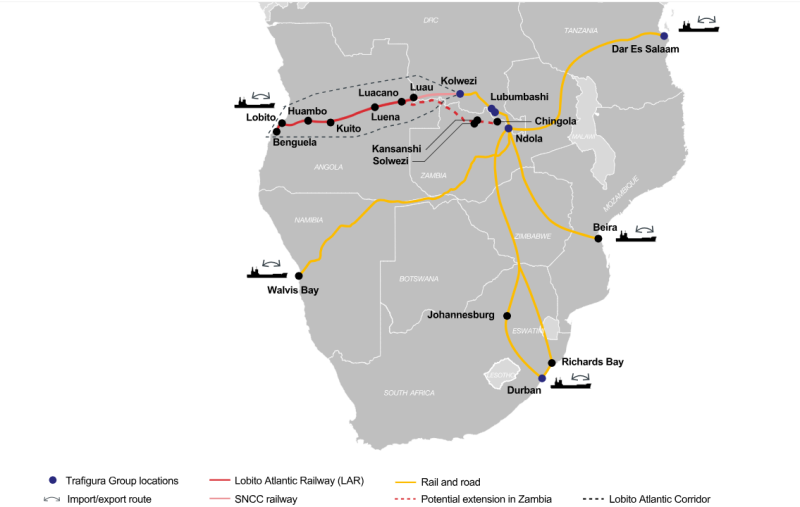In his first – and most likely last – visit to sub-Saharan Africa as US President this week, Joe Biden chose to focus on the planned upgrade of a cross-border railway that is set to take minerals needed for the energy transition out of Central Africa to the coast and on to the United States.
After walking among the cargo containers at Angola’s Lobito port, from where copper and cobalt will be shipped, Biden sat around a wooden table in a food processing facility with the leaders of Angola, Zambia, Tanzania and the Democratic Republic of Congo (DRC) for the Lobito Corridor Trans-Africa Summit.
He told his African peers that the Lobito Corridor railway project would be a “game changer”, bringing economic growth to Africa and the rest of the world. Currently, copper is transported to the port by road with truckers often stuck in queues for weeks at border crossings, but the railway’s supporters claim it will cut the journey time from several weeks to just days.
The White House said it was announcing over $560 million in new funding this week – including commitments expected to generate at least $200 million in additional private-sector capital – for infrastructure projects along the Lobito Corridor. US investments now total more than $4 billion, it said, adding that with G7 partners and regional development banks, international investment in the Lobito Corridor exceeds $6 billion.
The Lobito Corridor is an old, recently-restored railway which runs from the Angolan coastal port of Lobito 1,344 km to the border town of Luau, where it links with the railway of the cobalt-rich DRC. A coalition of local and Western companies and governments want to extend it to Zambia’s copper mines.
Transitioning from fossil fuels to clean energy will require huge amounts of copper to carry electricity and cobalt for batteries. The US and China are competing to source limited supplies of these materials for their electric vehicle manufacturers.
China is helping refurbish the Tazara railway linking Zambia’s Copperbelt province to Africa’s east coast in Tanzania. In Angola yesterday, Biden’s energy and investment adviser Amos Hochstein said that copper and cobalt is “now going to be switching direction on this corridor”.
Local benefits
Speaking after Biden, Zambian President Hakainde Hichilema said the project, which he drew up with Hochstein in his “dingy office” in Zambia’s capital, is a “huge opportunity” for Africa. He added that the minerals will “make our global economy greener”.
He stressed the importance of linking the railway with the Chinese-built Tazara eastern railway “which will really mean that we can connect our continent” from the west to east coast.
Sitting next to him, the president of neighbouring DRC, Felix Tshisekedi, said the project would create 30,000 jobs, reduce logistics costs, increase export revenues and offer “a strategic alternative to other exportation corridors”.
But of equal importance, he added, is the need to process the copper and cobalt locally before it is exported. “It is imperative that the wealth contained in our ground contribute directly to the well-being of our peoples,” he said through an interpreter.
Q&A: What you need to know about clean energy and critical minerals supply chains
Emmanuel Umpula Nkumba, executive director of the DRC-based African Natural Resources Watch, agreed, telling Climate Home that Africa has historically exported its raw minerals without benefiting from the finished products. “If this project will do the same, then there will not be a huge difference and we will not win in this transition,” he warned.
In a fact sheet, the White House said the US “is committed to ensuring reliable supply chains by supporting the development of this sector [critical minerals] with environmentally respectful processing so more of the value is captured on the continent”. It said US government support is being provided for a nickel mining and refining project in Tanzania, rare earths mining and refining in Angola, and a “green copper mining” project in Zambia.

Map of the Lobito Atlantic Railway Corridor (Pic: Trafigura)
Troubled railway
The Lobito railway was built by a British company in the early 20th-century and although its developers originally planned that it would reach Zambia’s copper mines, it only ever got as far as Angola’s border with the DRC.
It fell into disuse in the late 20th-century during Angola’s 27-year civil war. Zambian copper was mostly diverted east to Mozambique and then from 1976 on the Chinese-built Tazara Railway to Dar es Salaam in Tanzania.
In 2015, the Chinese government stepped in and carried out a $2-billion rehabilitation of the Lobito railway. But in July 2022, the Angolan government awarded a 30-year concession to maintain and operate the railway to a consortium of European companies led by Trafigura and Mota-Engil, rejecting a Chinese bid.
The Africa Finance Corporation, owned by private companies and the Nigerian government, has promised to try and mobilise $500 million in finance through various instruments to bring the Lobito railway to Zambia. The US government is aiming for construction of that stretch to start in 2026.
The US government has backed the Lobito project financially, with its Development Finance Corporation (DFC) approving a $553-million loan to improve the Angolan section of the railway and add more carriages to the trains.
Lithium boom: Zimbabwe looks to China to secure a place in the EV battery supply chain
However, with Donald Trump taking over the White House in January, it is unclear whether the Republican president-elect will support the project once in office.
There are pointers that Trump may well continue the project and possibly claim it was inspired by him because it is backed by the reformed Development Finance Corporation – America’s development finance institution which, alongside the private sector, funds solutions to challenges facing developing countries and was started during his first tenure. Reuters reported that two government officials who served under Trump say the next US president will likely back parts of the Lobito project.
The director of Chatham House’s Africa programme Alex Vines said Trump was likely to support the Lobito to Luau stretch of the railway. But, he said, “there are still some doubts” about whether the Trump administration would back the section connecting to Zambia and the Tazara railway, because of that railways links to China.
Asked whether the project was “Trump-proof” on the presidential plane to Angola, White House National Security Communications Adviser John Kirby said: “It’s our fervent hope that as the new team comes in and takes a look at this that they see the value too, that they see how it will help drive a more secure, more prosperous, more economically stable continent.”
This article was updated on 6 December 2024 to include Alex Vines comments
(Reporting by Vivian Chime; editing by Joe Lo and Megan Rowling)
The post Biden uses only Africa visit to promote “game changer” railway for copper and cobalt appeared first on Climate Home News.
